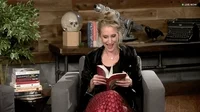
As I began to learn about this strategy, I thought it was a
cool way to engage students in the reading. I think the presentation went
pretty well. Out of nervousness, I felt like I ran through the PowerPoint a lot
faster than I anticipated. Marin and I experimented with working in groups versus
working alone and turning to talk with a partner. Although time could have been
a factor, I believe working in groups was more interactive. I think the students
enjoyed grouping the terms together and trying to predict what the article was
about. It was good walking around and watching everyone combining their prior
knowledge to determine which category to place each term. One group was able to
guess what the article was about, and I could see that they were glad to be
right. Essentially, I think it would depend on the group of students you have in
your classroom to determine whether or not groups work better. I think working
alone has its benefits as well where you get students to think on their own
first before talking to a peer to see where their thoughts were similar and
different. I also think we should have chosen better words for the second activity.
The words that were listed didn’t give anyone the impression that it was about
Hurricane Florence. It can also be a lesson learned to demonstrate why it’s
important to be very particular when choosing the terms without completely
giving it away. I think the first set of words was a great example because it
gave the right amount of clues from the terms without giving it away. There were
some students who had more knowledge about the science compared to others, but
that will also be accurate in our classrooms as well. Overall, I think we did well
and I really like this strategy. I can see myself using this strategy in my
classroom and this has shown me what I would do differently.
332
Autumn








